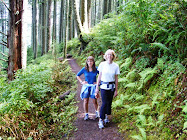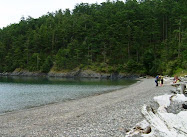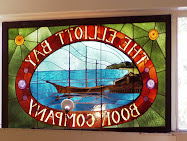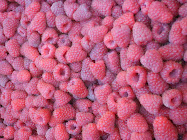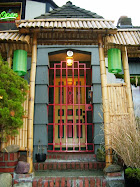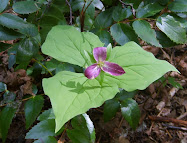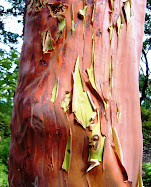 Want to really get away from it all? No wifi/cell reception, traffic, and streetlights, and quiet-except-the-sounds-of-nature away from it all?
Want to really get away from it all? No wifi/cell reception, traffic, and streetlights, and quiet-except-the-sounds-of-nature away from it all?It's getting harder since the Pacific Northwest has become a magnet for the thousands moving here the last several years. So a recent weekend getaway to Stehekin, way up in the mountains at the northern end of Washington's Lake Chelan, was a balm to my city-addled soul.
No roads lead to Stehekin. You can only get there by boat, small plane, or walking in over mountain passes (which I did many years ago). Any way you go, it's a journey.
The Voyage North
Friday morning we caught the once-a-day ferry at Fields Point Landing north of Chelan for the 3-hour cruise up lake on the Lady of the Lake. We snagged two seats in the fore bow, but spent most of our time out on the back deck in the breezy sunshine.
 |
| Lady of the Lake |
Along the way up the lake, it was disheartening to see the formerly forested mountains hugging the lakeshore now mostly bare with stands of dead snags, remnants of the many forest fires that have raged here the last two decades. After about 3 hours and a few stops along the way, we arrived at the collection of wood-framed low-rise buildings that are more or less "downtown" Stehekin.
The Arrival
Our lodging over the weekend was at the North Cascades Lodge (pictured above) adjacent to the boat landing. We came for a "Fireside Circle" weekend with Washington's National Park Fund (WNPF), a great nonprofit that raises funds to supplement projects in our under-budgeted national parks here in Washington.
WNPF had a full weekend of activities planned, so after settling into our rooms, most of our group of about a dozen hopped on a park shuttle to Rainbow Falls for a short walk, followed by a stop at the famed Stehekin Pastry Company. For a cookie monster like me, it's a dangerous place.
 |
| Lower Rainbow Falls |
Our weekend was organized around the annual Buckner Orchard Harvest Fest, which started with music Friday night at the one-room Stehekin School. While a couple of the amateur musicians stumbled on lyrics or chords, the easygoing crowd sang along in encouragement. A highlight was the school kids singing and a sweet father-daughter duo.
Saturday morning before the cider squeeze, some of us hoofed about 1,000 feet up the Purple Pass Trail behind the lodge before heading back down to catch the shuttle to the orchard. (Would like to go all the way up to the pass next time for even better views.)
A few miles beyond the head of Lake Chelan lies the Buckner Homestead, a designated Historic District inside the boundaries of the North Cascades National Park complex. Our destination was the the organic orchard, which is so isolated that no pesticides are needed.
 |
| naturally organic |
In this beautiful setting surrounded by mountains and exceptionally friendly locals, I was sold on the benefits of living in such a remote community many miles away from strip malls and box stores. It's a throwback to a simpler, rural American small town way of life that is sadly disappearing.
The Last Morning
When I awoke before sunrise after another night of deep quiet and a restful sleep, I grabbed my cameras and ran out to shoot the sunrise from the lakeshore. Although it was chilly, we were treated to a lovely show of changing light on the snow-dusted mountains above.
After breakfast at the lodge, most of our group caught the national park shuttle up the dirt road beyond Stehekin as far as it goes (about 12 miles). First we stopped at a Stehekin River crossing to see an abundance of crimson red kokanee salmon heading upstream to spawn.
At road's end, with about 15 minutes to hop out, I shot a few photos a short way up a trail. 'Twas indeed another beautiful day in the North Cascades, freshly frosted with new snow that fell over the weekend.
Before departure at 2 pm when the Lady of the Lake headed back south, several of us took full advantage of our last hour in paradise with a walk along the Lakeshore Trail as far as we could go. Then it was time to leave.
Too soon.
 |
| The pace of life in Stehekin |
Cramming a beautiful weekend of fun, great people, and more photos into one blog post is tight, so I'll leave it at that. You'll just have to see for yourself sometime.
We'd love to hear your Stehekin/Chelan/North Cascades experiences or answer your questions in a comment below.
Happy trails and thanks for visiting Pacific Northwest Seasons! In between blog posts, visit Pacific NW Seasons on FaceBook, Twitter, and Instagram for more Northwest photos and outdoors news.
When You Go
While you can visit Stehekin year-round, things do slow down in the winter. The Stehekin Pastry Company just closed last weekend for the season; look for it to reopen next spring. While we stayed at the convenient North Cascades Lodge at Stehekin, there are other options, like the cool Stehekin Valley Ranch. Here's the link for ways get to Stehekin. Hiking into and around Stehekin is my favored activity, but there are lots of other things to do.
And last but not least, think about getting involved or donating to Washington's National Park Fund. These days our parks especially need extra support.

































































